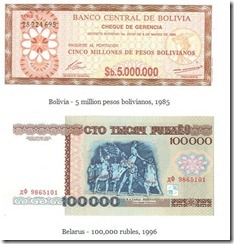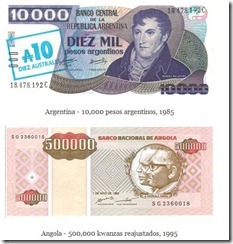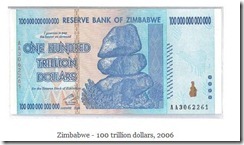First they ignore you, then they laugh at you, then they fight you, then you win- Mahatma Gandhi
It’s not that we didn’t see this coming, the Philippine Phisix closed this week at a milestone record nominal HIGH at 4,458.
For me, this signifies another “I told you so” moment, as cynics both from the mainstream economics and the mechanical charting camp have mistakenly stated that this won’t be happening soon.
Epic Breakout on a Divergent Marketplace
Yet such monumental breakout came amidst a wobbly and seemingly discordant global equity market.

It’s not that this epic moment has been isolated or represents a unique trait seen exclusively to the Phisix only, but rather, the ASEAN majors have been one of the best performing equity markets of late. In short, as I have repeatedly been pointing out, this has been a regional dynamic.
By our latest reckoning, the Philippines along with Indonesia, Malaysia and Thailand have been in the top 20[1] among the 78 bourses worldwide.
The abbreviated price actions of the FTSE ASEAN 40 (ASEA) Exchange Traded Fund [ETF], which is a newly constructed bellwether, exhibit this new height.
This has happened as most of Asia seems on the upside, as represented by the Dow Jones Asia Pacific index (P1DOW). Meanwhile, the US S&P 500 (SPX) seems edgy, but still has been manifesting upward inclinations.
Only the European benchmark (stoxx 50) appears to be the odd man out, considering the festering debt crisis which seems to be spreading to the PIIGS.
And nowhere has this seeming exceptional deviation by the ASEAN majors imply of “decoupling”.

As the charts above from CLSA/Businessinsider indicate[2], over the past two decades returns of Asian bourses have been converging.
This gives credence to my repeated assertions[3] that in the world of globalization, the correlation of global equity markets have been tightening.
Yet to view performance digressions as “decoupling” risks false and misleading interpretations of events that may result to wrong prognosis, overconfidence and consequent errant actions that could lead to monetary and psychic losses.
One would further note that divergent actions occur mostly during crisis or recessions, as in the Asian crisis of 1997, the dot.com bust in 2000 and the US mortgage bubble crash of 2008. However, the boom phase of a bubble cycle tends to show signs of re-convergence.
Not every of the market signals I earlier alluded to[4] participated in the confirmation of the local boom. Europe’s ongoing crisis has partly taken some steam off from the global equity market re-convergence.
If there is any lesson from the above, it is that the local and ASEAN boom would likely become stronger if global equity markets would act in consonance. Oppositely, a further widening of divergences would put to doubt the string of current advances.
Gold-Phisix Correlation Redux
There is another noteworthy development that needs to be emphasized, as the Phisix and ASEAN bourses have reached record territories, so has gold prices.

As I previously wrote about how gold’s price actions seem to lead the Phisix[5],
The implication is: for as long as the trend of gold prices remains to the upside, the Phisix will likely follow unless domestic factors become powerful enough to impel a disconnect.
Prices of gold have served as reliable barometer so far.
Alternatively, this also means that accrued corporate earnings or micro economics or mainstream’s macro views can hardly explain this phenomenon.
Consumption demand, which has been the popular perspective, can hardly explain the broad based increases in commodity prices along with equity prices.
Of course correlation does not imply causation or that there presents no causal relationship between gold and the Phisix.
The point is: both gold and the Phisix account for as symptoms of an underlying pathology, which has largely been an unseen factor.
Again correlation does not represent causation. Yet the degree of correlation may vary according the causal relationship dynamics that underpins these markets.
In my view, I see this relationship anchored on the unfolding (Austrian) business cycle or bubble cycle fueled by monetary policies.
And the political process in fostering such boom phase of this bubble cycle has clearly been at work.
In the US, Federal Reserve chairman Ben Bernanke recently placed the QE 3.0 option on the table[6] partially confirming my forecasts[7].
Although Mr. Bernanke partly backtracked[8] from his earlier stance by stating that while QE 3.0 is in the cards it will not be used soon.
I see this as part of the mind conditioning-communication tactical tools used by the central bankers (or the signaling channel) to influence market expectations (aside from indirect market interventions).
The important point is that the Fed seems to be projecting the idea of renewed access to QE which is a sign of imminence. The question isn’t about an IF, but rather a WHEN.

And the commodity markets seem to have been affirming such expectations. Even the perennial laggard Natural Gas (NATGAS) appear to be on the rise. Silver, oil (WTIC) and the CRB Reuters (CCI) have been on climbing higher, despite the string of recent interventions.
Of course I don’t think Mr. Ben Bernanke would automatically employ QE or its variant, that’s because QE is a political tool designed at attaining political ends.
QE 3.0 will likely be tied to the congressional vote on the US debt ceiling, the deadline[9] of which is on August 2nd is fast approaching.
The political pressure to raise the debt ceiling continues to intensify as major credit rating agencies as the S&P and Moody’s has warned of a possible downgrade[10] if a deal won’t be reached.
Higher prices of Credit Default Swaps (CDS)—an insurance against default risks—on US sovereign debt (see left window below[11]) has been attributed to the recent political impasse.

Although in perspective, the rising prices of US CDS can be seen amidst a backdrop of general concerns over credit risks for most of the world[12] (including the Philippines which is two notches below the US), but especially for many European countries over a one month frame. In short, politicking may have led to the misplaced focusing effect for many politically blinded observers.
The above reveals that the causation link of higher US CDS prices and political stalemate over the debt ceiling seems unclear.
The other major factor that could prompt Ben Bernanke to reactivate QE 3.0 soon is if the debt crisis in the Eurozone escalates to the point of putting US banks at risk. As pointed out in the past[13], QE 2.0 has reportedly benefited foreign banks or had been used as an indirect channel to conduct bailouts of Eurozone banks through the Eurodollar market.
I wouldn’t know which of these events would prompt Mr. Bernanke to trigger the next version of QE, but one thing is certain, given the trillions of bailouts thrown to US banks (demonstrated preference or actions as proof of the order of priorities), combined with ideological or doctrinal leanings and path dependency, plus reluctance to adapt fiscal discipline as the necessary path for reform, all these point towards the QE option to secure or safeguard the tripartite government-banking system-central bank political structure.
All these imply that monetary accommodation will prevail over marketplace for a longer period of time which should support the current risk environment.
And given that the global transmission of credit easing (QE) policies and artificially suppressed interest rates everywhere would have different impacts on different asset classes, the gold-phisix correlations, unless the latter would be influenced more by domestic factors, will likely be sustained.
Market Breadth and Internals Point to Further Strength
Since financial markets are driven by psychology, underpinned by the above forces, people’s outlook can be measured from actions being undertaken from different financial market indicators.
The milestone breakout by the Phisix has been bolstered by the broader market.

Market breadth has been broadly positive as all sectors posted gains (left window).
Again the Philippine composite has been elevated by mostly the mining sector followed by the financial sector, particularly led by Metrobank [PSE: MBT].
Advance decline spread (weekly basis) has likewise turned significantly positive (right window).

Market internals have also demonstrated broad bullishness.
Average daily trades (weekly basis) and daily number of issues traded (weekly basis) has dramatically improved.
While no trend goes in a straight line, such congruent positive actions are likely signs of continuity. Importantly, such trends could reaccelerate.
Philippine Peso Driven by Portfolio Investments
This week the Philippine Peso has partially departed from its tight correlation with the Phisix.
The monumental advance of the Phisix saw the Peso soften instead. The Peso seems to reflect more on the region’s actions than to confirm the Phisix’s vigorous advances. Or maybe currency intervention by the local central bank could also be a factor.
Although one week does not a trend make, I think that the Peso should eventually make more confirmations of the actions of the Phisix and vice versa.
As I keep saying[14],
this has been premised mostly on the favorable relative demand for Peso assets, aside from the lesser inflationary path by the Peso based on the supply side.
There is no proof stronger than this.

The chart above from the World Bank[15] and yahoo finance shows that Philippine Peso has hardly been driven by remittances, which has been peddled by the mainstream, but by virtue of correlations based causal logic the net capital flows (manifested mostly by portfolio investments).
For as long as the net capital flows (again mostly by portfolio investments) continue to expand, some of which will be evidenced in the actions of the Philippine Stock Exchange, we should then expect that this would be reflected on a rising Peso.
Bottom line: Again momentum, via various market signals, favors the confirmation of this week’s epic breakout.
We should see the Phisix at 4,900-5,000 by the yearend barring any exogenous shocks.
[1] See How Global Equity Markets have Measured Up to the PIIGS Crisis, July 13, 2011
[2] Weisenthal, Joe This Is What Global Market Correlation Looks Like, Businessinsider.com, July 11, 2011
[3] See ASEAN’s Equity Divergence, Foreign Fund Flows and Politically Driven Markets, June 5, 2011
[4] See I Just Can’t Get Enough: Philippine Phisix Emits Intensely Bullish Signals, July 3, 2011
[5] See How External Forces Influence Activities of the Phisix, May 29, 2011
[6] See Ben Bernanke Hints at QE 3.0 June 13, 2011
[7] See Poker Bluff: No Quantitative Easing 3.0?, June 5, 2011
[8] See Ben Bernanke on QE 3.0: Not Now, But An Open Option, July 15, 2011
[9] Reuters.com Obama, lawmakers press ahead for elusive debt deal, July 16, 2011
[10] Bloomberg.com Moody’s Downgrade Warning Adds Pressure on U.S. Debt Deal, July 14, 2011
[11] Zero Hedge, US Default Risk Jumps To Highest Since February 2010 On Debt Ceiling Worries, July 14, 2011
[12] Bespoke Invest, Changes in Sovereign Debt Default Risk Over the Last Month, July 16, 2011
[13] See Political Interventions has Led to the Widening of Divergences in Global Asset Markets, June 26, 2011
[14] See I Just Can’t Get Enough: Philippine Phisix Emits Intensely Bullish Signals, July 3, 2011
[15] Worldbank.org, Generating More Inclusive Growth, Philippine Quarterly Update June 2011




























